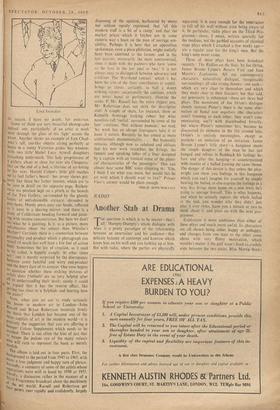ART
View Halloo
.rrnts is a big book* literally; thirteen inches 1 by eleven inches and an inch thick. The suspicious-minded, who have been had this way before, will assume that it is one of those coffee- table Tattles' dubbed 'sumptuous' and never opened a second time. Here at least there is a text and a full one, to pursue, peruse, sometimes question, often agree and approve. It is not mere caption material pasted in round the photo- graphs, though it is the photographs by Lord Snowdon, 101 in colour and 267 in black and white, which are the basis of the album.
* PRIVATE Vim. Photographs by Lord Snowdon• text by Bryan Robertson and John Russell. (Nelson. 7 gns.) the Rt the th
Dr bu ay to
wt m.
Lord Snowdon its reason, I have no doubt, for existence.
Some of them are very beautiful photographs indeed; one, particularly, of an artist at work se !It through the glass of his 'light' across the street. Another shows an example of Lyn Chad, wick's tall, axe-like objects sitting perfectly at home in a sunny Victorian gothic bay window. with two little Mabel Lucy Attwell daughters crouching underneath. The lady proprietress of a L.illery about to close for ever sits Cleopatra- like on the.end of a bed, a lifetime of art-loVing in her eyes. Harold Cohen's little girl reaches LIP to feel father's beard: her jersey shows pat- ns like those her father invents, which are to be seen in detail on the opposite page, Rothen- skin sits perched high on a plinth in the bowels or the Tate Gallery, surrounded by the ghostly forms of unfashionable statuary, shrouded in Polythene. Hendy peers over our heads, reflected as it were in a shaving mirror, and there is a Study of Coldstream bending forward and paint- ing with intense concentration. But here we don't Se ! what he is painting. Is it, as a picture, more informative about the subject than Whistler's Mother? Certainly there is a connection between PersOnality and product which a photograph can reveal (if much less well than a few feet of action tit,SometiMes the joy of creation, as it used l0 be called, is happily caught. At other times one is merely surprised by the discrepancy between some fanciful and witty end-product and the beery face of its creator. One even begins to question whether these striking pictures of artists dans l'intimite are so very helpful after all In understanding their work; surely it could be .argued that it has the reverse effect, like getting too close to a Sylphide and hearing how she pants?
Now, when you set out to study seriously = boom in modern art in London--John lssell and Bryan Robertson maintain firmly = thesis that London has become one of the ''ee capitals of art in the modern world—it is 'elsely the suggestion that you are offering a II.IPer Colour Supplement which needs to be olded. There is too often the hint of just that escape the jealous eye of the many refuses 10 will rush to represent the book as merely 3dish.
The album is laid out in four parts. First, the background to the period from 1945 to 1965, with Secondly, a true judgment and happy turn of phrase. reputations a summary of some of the artists whose 1.1)ulations were well in hand by 1950 or 1955. Thirdl!rdlY, a discussion rather in the manner of a 01 ly, rd Programme broadcast about the machinery th .tbe art world. Russell and Robertson get '1r points over rapidly and confidently, largely
disposing of the opinion, harboured by many but seldom openly expressed, that 'all this modern stuff is a bit of a ramp,' and that the market prices which it fetches are in some esoteric way a hoax on the man of average sen- sibility. Perhaps it is here that an opposition spokesman, even a plain philistine, might usefully have been admitted to the forum; and in the last quarter, necessarily the most controversial, since it deals with the painters who have 'come to the tore in the last year or two,' it is not always easy to distinguish between advocacy and criticism. The 'first-hand contact.' which it has been the aim of the three contributors to supply, brings us closer, certainly, to half a dozen striking talents: occasionally the captions. which are never banal or perfunctory, illumine the scene. If Mr. Russell has the more elegant pen, Mr. Robertson does not shirk the descriptive stint. A couple of shots, for instance, show us Kenneth Armitage looking robust but what novelists call 'rueful,' surrounded by some of the later creations. 'Not without humour,' we read, 'his work has an abrupt foursquare take it or leave it nature. Recently he has aimed at more architectonic monumentality. . . . But humanity remains, although now so subdued and oblique that his new work resembles the fittings, the funnels and speaking tubes of a liner designed by a captain with an ironical sense of the physi- cal characteristics of the passengers.' One can almost hear some BBC voice chipping in: I think I see what you mean, but would this be art with which I should want to live?' Private View's answer would be plain enough.
PHILIP HOPE-WALLACE







































 Previous page
Previous page